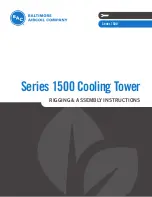
81
YORK INTERNATIONAL
FORM 100.50-NOM1 (604)
5
the “
Hydro Heat 1
st
Stage”
is
Þ
eld adjustable but is
factory set with a default value of 100
0
F. Under the
SETPOINTS key of the OptiLogic control panel the
“
Hydro Heat 2
nd
Stage”
is
Þ
eld adjustable but is factory
set with a default value of 115
0
F.
The Furnace Controller, found in the gas heat section,
will also be con
Þ
gured at the factory based on the num-
ber of gas heat sections installed. This con
Þ
guration
is performed at terminal 5 and 6 of terminal block TB2
of the Furnace Controller. If there is a single heat sec-
tion installed there will be no connection between the
two terminals. If there is two heat sections installed
there will be a 1K ohm ½ watt resistor between the two
terminals. If there is three heat sections installed there
will be a jumper between the two terminals.
The Primary Unit Controller generates a 0 to 10 volt sig-
nal to the Furnace Controller based on the temperature
difference between the supply air temperature (SAT) and
the “
Hydro Heat 1
st
Stage”
or
“Hydro Heat 2
nd
Stage”.
Refer to Table 16 and 17 for an explanation on how
the Primary Unit Controller determines when heating is
required for the different modes of unit operation.
The 0 to 10 volt output represents a 30 degree tempera-
ture range (3 degrees = 1 volt). The midpoint of the 30
degree range is the SAT midpoint. This midpoint equals
a 5 volt output to the Furnace Controller.
The Furnace Controller has a d/- one degree
offset from the midpoint. When the voltage input to the
Furnace Controller is between 4 and 6 volts the control-
ler maintains the current state of furnace operation, it
will neither increase nor decrease the amount of heat.
When the voltage is between 6 and 10 volts, the Furnace
Controller increases the heating output. When the volt-
age is between 0 and 4 volts, the Furnace Controller will
decrease the heating output.
A voltage greater than 5 volts is required for the modu-
lating furnace section to start. A voltage level less than
1 volt will turn the furnace off.
COMPRESSOR OPERATING CONTROLS
The following information describes the sequence of
operation for the compressor unit control components.
The information below describes System 1A and 1B
compressor operation. This same information can also
be applied to System 2A and 2B and System 3A and
3B.
• When the Primary Unit Controller identi
Þ
es a need
for compressor operation it energizes the Cooling
Change Over Relay (C/O) 12R and switches the
binary outputs BO1 for compressor A1 operation
and BO2 for compressor A2 operation from the
Primary Unit Controller to the smart Relay SR1.
•
The Smart Relay SR1 sends a 120 volt output
from the Q1 output (compressor 1A) Q2 (compres-
sor 1B) to the 1M (compressor 1A), 2M (compres-
sor 1B) contactor which energizes compressor 1A
and/or 1B.
• The Smart Relay SR1 also sends a 120 volt putput
from the Q3 ouput to the 7M contactor which en-
ergizes one condenser fan.
• The Smart Relay also receives an input signal from
an ambient thermostat 9STAT at terminal I5. The
thermostat opens at 75
0
F and closes at 85
0
F. If the
switch is closed and there is a call for both com-
pressor 1A and 1B the Smart Relay will send a 120
volt signal from terminal Q4 of the Smart Relay to
the 8M contactor and the second condenser fan for
system 1 is energized.
• Flexsys units have a solenoid valve (4LLSV) in-
stalled prior to one of the two system expansion
valves in order to keep one half the system circuit
inactive unless both compressor are on. Both com-
pressor contactors 1M and 2M have auxiliary nor-
mally open contacts that close when the contactor
is energized. The two auxiliary contacts are in
series and control the operation of the solenoid
valve. Both the auxiliary contacts must be closed
before 120 volts is supplied to energize and open
the solenoid valve.
• If pumpdown is installed on the unit the solenoid
valve in the main system liquid line (1LLSV) will
be energized with the 7M contactor at the beginning
of the cycle.
• The Smart Relay uses an input to terminal I4 to
monitor the condition (open or closed) of the
low pressure switch. When a call for mechanical
cooling for System 1 is removed, the Smart Relay
deengerizes the Q3 and Q4 outputs which opens
contactors 7 and 8 M and deenergizes the liquid
line solenoid valve (1LLSV).
















































